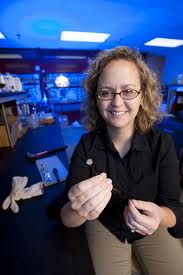
A Colorado State University professor has successfully turned a mineral compound into a material that can pass current through a nanoparticle network – an important discovery into more efficient, inexpensive solar cell materials.
Amy Prieto, professor of chemistry and founder of Prieto Battery, discovered that dramatic reactions occur with copper selenide at the nanoscale, according to the cover story in the Feb. 9 issue of the Journal of the American Chemical Society. Reactions with air allow Prieto and her students to manipulate or “tune” the properties of the device – such as a solar cell – containing the copper compound.
That’s an important discovery for looking further into earth-abundant, non-toxic materials that could help make solar cells inexpensive and absorb sunlight more efficiently than silicon, Prieto said.
“Nanoparticles are so small, therefore most of the surface reactions that you would never notice in bulk materials are pretty dramatic in a nanoparticle,” Prieto said. “There is getting to be a lot of interest in making devices like solar cells from nanoparticles.
“There is still much to be understood about how the material we’re now using works – how it absorbs photons and converts them to current, that then has to traverse a tortuous path through the nanoparticle network” she said.
Prieto and her team tested the copper nanomaterial by attaching electrodes to thin films of copper selenide nanoparticles and watching how the thin films pass electric charges. They found that, with prolonged air exposure, the current changed dramatically.
Prieto’s research focuses on creating new inorganic materials – to replace silicon or cadmium telluride, for example – that could be incorporated into solar panels to produce electrical current.



